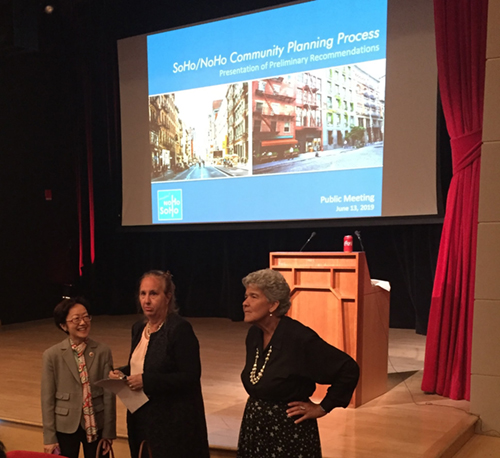Bowery Boogie | October 14, 2020
The following editorial was written by Kirsten Theodos and Lynn Ellsworth of Human-Scale NYC.
In January 2019 the Department of City Planning, Councilwoman Margaret Chin, and Manhattan Borough President Gale Brewer held a series of public meetings with the thinly veiled goal of rezoning the adjoining, historic neighborhoods of SoHo and NoHo. To say it got off to a rocky start would be an understatement. Bowery Boogie reported the first meeting was held in a microphone-less room, too small to accommodate the hundreds of people who showed up. It was unclear who’d be speaking or if anyone from DCP, Chin or Brewer’s office was even there. Hand-outs alluded to a plan without mentioning “rezoning.”
As it happens, Chin was seemingly hiding in the back; and Brewer arrived late and had to climb a tabletop to address a crowd frustrated by a lack of transparency about what was happening. Even Brewer herself admitted the kickoff event “sucked.”
Over the next six months, city officials proceeded to hold public workshops where neighborhood residents and small business owners voiced concerns. Such as displacement, demolition of older buildings with affordable housing and small businesses, towerization, and excessive commercialization in an area more in need of a supermarket.
The inconclusive workshop recommendations were released just before Thanksgiving that year (so maybe nobody would notice?) in the “Envision SoHo/NoHo” report. It vaguely called for further “community involvement and transparency…to allow time for residents and other stakeholders to contemplate the proposed recommendations” before a follow-up at the Community Board. In a public forum, Brewer’s office confirmed “there is no plan for a ULURP anytime in the near future.” A City Planner then abruptly grabbed the mic and stated there would be “no more questions.” Mayor de Blasio later admitted there wasn’t enough time left in his administration to get a complicated and time-consuming rezoning passed.

Councilmember Margaret Chin, MBP Gale Brewer, and Director of City Planning Marisa Lago
So after nine months of silence, it was rather shocking last week when the Mayor announced the start of the public land review process for rezoning SoHo/NoHo, disingenuously suggesting it was in the name of “racial justice,” a concept that was blatantly ignored in his previous upzonings of neighborhoods of color like East New York, Inwood, East Harlem and Jerome Avenue. And what about the promise to follow up with the Community Board?
So who is really behind this push? Surprise, surprise: Big Real Estate. Especially the Gottesman family real estate dynasty behind Edison Properties, whose firm sits on REBNY’s Board of Governors. Two of Edison’s large parkings lots sit in the proposed upzoning, making it the ultimate beneficiary. Citizens Housing & Planning Council’s (CHPC), which includes an executive from Edison on its board, published a piece supporting the upzoning. Among the many other REBNY notables on CHPC’s board is the legal & lobbying firm of Kramer Levin Naftalis, who is running a print and TV media blitz in support of the upzoning. They’ve advised the land use process needs to be underway to ensure it’s done by the time de Blasio leaves office, presumably because anti-real estate sentiment in the city is only getting louder. We can connect the dots to see why this was suddenly resurrected during a global pandemic: time is running out for Edison Properties to develop their lots under a favorable regime, not because of “anti-police protests sparked by the killing of George Floyd” as Deputy Mayor Vicki Been shamefully said.
The city’s proposal to upzone SoHo/NoHo could easily end up doubling building heights when a developer combines air rights transfers with bonuses in the Mayor’s Mandatory Inclusionary Housing (MIH) program. And why do this? The trickle-down affordable housing approach is a policy failure that isn’t a solution. In fact, the city admitted in a public hearing that, as of November 2019, only 2,000 “affordable” apartments were built since the MIH upzoning law was passed in 2016. The SoHo/NoHo upzoning will flood the area with 2,400 luxury units compared to 800 “affordable” ones. If there are over 15,000 vacant apartments in Manhattan, why should thousands of new luxury units get injected where there is no green space of any substance, congested sidewalks, overcrowded schools and crumbling subways that were over capacity pre-Covid?
To be clear, Human-Scale NYC agrees the city needs affordable housing but not in exchange for three times as many units in luxury towers. Upzonings only enrich developers and fail to build truly affordable housing for the folks who need it the most. Time for de Blasio to go, and for a new Mayor to embrace a less destructive approach to affordable housing.

